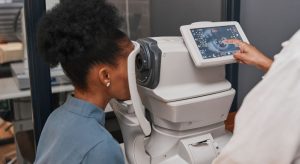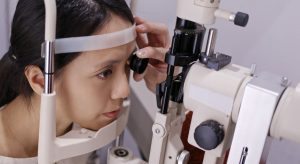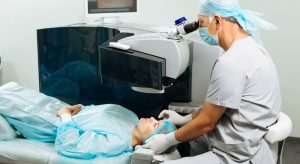PRK Eye Surgery for Active Military, Police & High-Impact Roles

If you’re considering a career in the military, police, firefighting, aviation or any physically demanding field, you may already know that vision requirements can be strict. Clear, dependable eyesight is essential when you’re working in unpredictable environments where every second matters. Because of these demands, many people in high-impact roles start comparing PRK with LASIK, hoping to find the safest and most reliable vision correction option.
The truth is that PRK has become the preferred choice for many armed forces and emergency services worldwide. Its flap-free nature makes it uniquely suited to environments where trauma, pressure changes and physical contact are common. In this guide, I want to explain why PRK is frequently approved for military and police roles, how it compares with LASIK, what you can expect from the procedure and why it’s often considered the safest long-term option for high-impact careers.
Why Vision Correction Matters for High-Impact Careers

High-demand professions require you to rely on your vision in a wide range of challenging situations.
You may need to:
- Track movement quickly
- React instantly to visual cues
- Identify objects in bright or low-light conditions
- Read instrument panels or tactical displays
- Navigate unfamiliar areas
- Work through dust, sweat, debris, impact or rapid motion
Any sudden drop in visual clarity could put you or others at risk.
This is why choosing the right type of vision correction is essential before entering these careers.
What Makes PRK Different from LASIK?
Although both PRK and LASIK reshape the cornea to correct vision, they differ in one crucial way: LASIK creates a flap, while PRK does not.
LASIK:
- A thin corneal flap is created
- Tissue beneath the flap is reshaped
- The flap is repositioned
PRK:
- No flap is created
- Only the surface epithelium is removed
- Laser reshapes the corneal surface
- The epithelium grows back naturally
This difference is the main reason military and police vision standards often prefer PRK.
Why PRK Is Safer for Military, Police and High-Impact Roles

Let’s explore the specific advantages that make PRK such a strong choice for these professions.
No Flap = No Risk of Flap Displacement
LASIK’s corneal flap is permanent. Even years after surgery, trauma could dislodge or damage it.
Situations where flap issues may arise:
- Close-quarters combat
- Rugby-like physical contact
- Strikes to the face
- Explosions or debris
- Falls or abrupt impacts
- Rapid acceleration or deceleration
With PRK, there’s no flap to dislodge, which eliminates one of the biggest long-term risks of LASIK for people in high-impact environments.
Approved by Most Military and Emergency Services
Many organisations specifically allow or even recommend PRK.
PRK is widely approved by:
- The US military (Army, Navy, Air Force, Marines)
- UK armed forces (many branches)
- Police services worldwide
- Fire and rescue departments
- Aviation sectors
- Special forces units
By contrast, LASIK is sometimes restricted or requires additional clearance due to flap-related concerns.
Better Stability in High-Stress Environments
Because PRK reshapes the cornea directly, the outcome is extremely stable.
There’s no chance of flap-related complications if:
- Your eye is hit
- Your head is jolted
- You experience pressure changes
- You operate in extreme weather
This makes PRK ideal for soldiers, officers, pilots, divers and tactical specialists.
Lower Risk of Dry Eye for High-Demand Environments
Jobs with long hours, exposure to wind, heat or air-conditioning often worsen dry eye symptoms.
PRK advantages:
- PRK doesn’t cut corneal nerves as extensively as LASIK
- Less long-term dryness
- More stable tear film
For pilots, officers or firefighters, dryness can instantly reduce clarity during critical moments.
Better for Dusty, Dirty and High-Debris Environments
Military operations, construction-based rescues and riot-control situations often involve:
- Sand
- Dust
- Smoke
- Debris
- Harsh weather
PRK avoids the flap that could trap debris under the surface, making it safer for jobs with environmental hazards.
Stronger for Close-Quarters Combat (CQC)
If your career involves training or real scenarios involving:
- Hand-to-hand combat
- Tactical takedowns
- Wrestling
- Riot control
- Crowd engagement
PRK is safer because there’s no flap that could loosen under pressure.
Reduced Risk With Headgear and Protective Equipment
Many high-impact roles require:
- Helmets
- Night-vision goggles
- Tactical eyewear
- Respirators
- Dive masks
Pressure or suction from this equipment can affect the LASIK flap something PRK avoids entirely.
PRK vs LASIK for Military & Police: Quick Comparison

Flap-Free Design
- PRK: Flap-free procedure.
- LASIK: Involves creating a corneal flap.
Military Approval
- PRK: Fully approved across most military and police forces.
- LASIK: Approved in many cases but still restricted for certain roles.
Impact Safety
- PRK: Very safe for high-impact situations (no flap to dislodge).
- LASIK: Higher risk due to the presence of a permanent corneal flap.
Dry Eye Risk
- PRK: Lower long-term dry eye risk.
- LASIK: Higher dry eye risk because of corneal nerve disruption during flap creation.
Recovery Time
- PRK: Longer recovery and slower vision stabilisation.
- LASIK: Faster recovery and quick visual improvement.
Long-Term Stability
- PRK: Excellent long-term results with no flap complications.
- LASIK: Also excellent long-term vision but the flap remains for life.
High-Debris Environments (Dust, Sand, Smoke)
- PRK: Safer no flap to be affected by debris or trauma.
- LASIK: Requires caution as impact or debris could affect the flap.
Why Military and Police Recruiters Prefer PRK
Recruiting bodies prioritise safety and operational readiness. Because LASIK carries a small but permanent risk of flap displacement, many forces either prefer or outright require PRK.
Key reasoning:
- Soldiers may face blasts or shockwaves
- Police may be struck during arrests
- Firefighters operate in intense environments
- Tactical gear adds pressure on the face
- Aviators experience rapid pressure changes
PRK simply fits the demands more safely.
Is PRK Suitable for All Military and Police Applicants?
Not always PRK suitability depends on your eye condition.
You may be a strong candidate if:
- You have a healthy cornea
- Your prescription is within treatable limits
- You don’t have severe dry eye
- You want long-term safety
- You need stability under impact
You may need further assessment if:
- You have thin or irregular corneas
- You have high astigmatism
- You have early presbyopia (40+)
- Your lens is ageing or cloudy
- You have certain eye conditions
A full eye assessment determines the best approach for you.
How Recovery Works for High-Impact Professionals
PRK has a longer healing period than LASIK but offers exceptional long-term stability.
Typical recovery milestones:
Day 1–3:
Discomfort, watering, light sensitivity.
Week 1:
Surface layer heals; bandage contact lens removed.
Week 2–4:
Vision improves steadily; fluctuations are common.
Month 3:
Vision stabilises; clarity improves significantly.
Month 6:
Final results in most cases.
When can you return to training?
- Light desk duties: 5–7 days
- Light physical activity: 2–3 weeks
- Intense training or combat: 6–8 weeks
- Full tactical deployment: as advised by surgeon
Your role determines the timeline.
PRK in Real-Life High-Impact Scenarios
Let’s look at specific careers.
Active Military and Special Forces
PRK is widely used because it tolerates:
- Impact
- G-force
- Rapid motion
- Harsh terrain
- Explosions
- Weapon recoil
- Tactical gear pressure
LASIK’s flap simply isn’t ideal for special forces roles.
Police and Armed Officers
Daily policing involves unpredictable physical contact.
PRK offers:
- No flap risk
- Stable vision under pressure
- Better safety during arrests, grappling or riot gear use
LASIK is sometimes disallowed depending on the recruitment branch.
Firefighters and Emergency Responders
Firefighters operate in extreme environments:
- Smoke
- Heat
- Sudden movements
- Visibility changes
- Equipment pressure
PRK is ideal for these conditions.
Pilots (Military and Civilian)
Aviation demands:
- Rapid pressure change tolerance
- High-contrast clarity
- Precision vision
PRK avoids flap-related issues that some aviation regulators consider risky.
Divers, Coastguard & Marine Roles
Underwater or maritime environments involve sudden pressure changes and mask pressure. PRK is better suited to these roles than LASIK.
Athletes and Combat Sports
People who participate in:
- Boxing
- MMA
- Judo
- Rugby
- Wrestling
choose PRK for its flap-free safety.
Long-Term Performance: PRK Benefits for High-Impact Lifestyles
Once healed, PRK can provide excellent stability.
Key advantages:
- Permanent corneal reshaping
- No long-term flap concerns
- Lower chance of trauma complications
- Strong night vision stability
- Great for contact and environmental exposure
PRK results last decades and adapt well to high-demand lifestyles.
Long-Term Vision Considerations After PRK
PRK is extremely effective, but it doesn’t prevent natural aging changes.
You may still experience:
- Presbyopia after 40
- Cataract development after 50–60
- Natural lens changes
However, these changes occur regardless of PRK or LASIK.
PRK vs Contact Lenses for High-Impact Careers
Many people in military or police roles can’t safely use contact lenses.
Issues include:
- Dry environments
- Dust and debris
- Contamination risk
- Difficulty maintaining hygiene in the field
- Lens dislodgement under pressure
- Oxygen deprivation in demanding environments
PRK eliminates all of these concerns.
Frequently Asked Questions:
- Is PRK safer than LASIK for military and police applicants?
Yes, PRK is generally considered safer for people entering military, police or other high-impact professions. The reason is simple: PRK does not involve creating a corneal flap. Since LASIK leaves behind a permanent flap that can potentially shift or dislodge if the eye is struck, military recruiters prefer a flap-free option. PRK eliminates this long-term risk, making it more compatible with environments where impact, sudden motion or trauma are possible. - Why do many armed forces still restrict LASIK?
LASIK is restricted in many branches because the corneal flap it creates never fully reattaches in the same way natural tissue does. Even years after the procedure, a sudden blow, rapid pressure change or forceful contact could affect the flap. Military organisations consider this a potential operational hazard, especially for infantry, special forces, pilots or anyone working in unpredictable combat or training settings. PRK avoids these limitations, so clearance is typically easier. - How long before I can return to full physical training after PRK?
The exact timeline varies, but most people return to lighter duties after the first week and resume more active training after two to three weeks. High-impact or combat-related training usually requires six to eight weeks of healing because the eyes need enough time for the regenerated surface layer to stabilise. Surgeons normally give personalised clearance depending on your recovery, your specific role and the physical demands of your training program. - Does PRK affect eligibility for special forces or aviation roles?
In most cases, PRK is either preferred or fully accepted for special forces, aviation units and high-risk tactical divisions. These roles demand exceptional visual stability under pressure, and PRK’s flap-free structure is ideal for those conditions. Many aviation authorities, including military branches, favour PRK because it eliminates the risk of flap-related displacement during rapid G-force changes or sudden pressure variations experienced in flight. - Will PRK make my eyes more sensitive in dusty or extreme environments?
During the early healing stages, the eyes may feel slightly more sensitive to wind, dust and dry air, but this is temporary. After full recovery, PRK-treated eyes generally handle extreme environments extremely well because there is no flap that can trap debris or shift due to environmental exposure. Many people working in sandy, smoky or high-debris areas find PRK more comfortable long-term than contact lenses or LASIK. - Can PRK improve night vision for tactical or low-light operations?
Many patients report clearer night vision after PRK once the healing phase is complete. During the first few weeks, it is normal to experience halos or glare, but these visual effects gradually fade. In the long run, PRK provides very stable night vision because the corneal surface remains intact without the interface layer created by LASIK. For activities that require night driving, night patrol, low-light combat drills or aviation tasks, PRK is often a strong choice. - Is the recovery from PRK too slow for someone preparing for recruitment?
The recovery timeline needs planning, but it is manageable for most applicants. PRK requires more downtime than LASIK, especially during the first week, when the protective bandage lens supports the healing process. However, once the surface heals, vision continues to improve steadily, and by three months most applicants achieve their full corrected clarity. If you are preparing for a recruitment deadline, scheduling PRK a few months in advance ensures that you meet the required visual standards on time. - Will PRK affect my ability to wear helmets, masks or tactical goggles?
PRK is actually better suited for people who need to wear pressure-based gear such as helmets, respirators, dive masks, ballistic goggles or night-vision devices. Because there is no flap on the cornea, there is no risk that suction or pressure from these devices will interfere with healing or long-term stability. After full recovery, you can wear protective gear without worrying about displacement or sensitivity that sometimes occurs with LASIK patients. - Is PRK a permanent solution for vision, or will I need more corrections later?
PRK permanently reshapes the cornea, so the improvements it provides are long-lasting. Many people enjoy stable vision for decades. However, PRK doesn’t stop natural ageing changes like presbyopia, which affects reading vision after age forty, or cataracts, which develop later in life. These changes are unrelated to laser eye surgery and happen even to people with naturally perfect eyesight. For distance vision, PRK is typically a lifelong solution. - Is PRK worth it compared to just wearing contact lenses during training?
For high-impact professions, PRK is usually far more practical than contact lenses. Contacts can dry out quickly in windy, dusty or hot environments and may dislodge during combat, water-based scenarios or rapid movement. They also require strict hygiene, which is difficult in field conditions. PRK eliminates these problems by providing stable, hands-free vision that does not depend on supplies, cleaning or replacement. This convenience is one reason many applicants choose PRK before entering rigorous training.
Final Thought: Choosing the Safest Vision Option for Demanding Roles
PRK continues to be one of the safest and most reliable vision correction options for people preparing for military, police, aviation or other high-impact careers. Its flap-free design offers long-term stability, making it well-suited to environments where sudden impact, pressure changes or tactical equipment can pose risks. Once healed, PRK provides dependable, low-maintenance vision that supports the demands of physically intense roles.
If you’re exploring whether PRK surgery in London could benefit you, get in touch with us at Eye Clinic London to schedule your consultation. Our team can guide you through your suitability, expected recovery timeline and the visual standards required for your chosen profession. With the right planning, PRK can help you move forward confidently toward your career goals.
References:
- Eydelman, M., Drum, B. & Holladay, J.T. (2019) ‘Long-term outcomes of refractive surgery performed during the military’, Journal of Refractive Surgery, 35(10), pp. 635–639. https://pubmed.ncbi.nlm.nih.gov/31125090/
- Saini, J.S., Saini, S. & Saini, R. (2004) ‘The safety and efficacy of photorefractive keratectomy after laser in situ keratomileusis’, Journal of Cataract & Refractive Surgery, 30(12), pp. 2689–2693. https://pubmed.ncbi.nlm.nih.gov/16128332/
- Wilson, S.E. (2016) ‘Corneal wound healing after PRK and LASIK’, Journal of Refractive Surgery, 32(5), pp. 354–365. https://www.ncbi.nlm.nih.gov/pmc/articles/PMC4851218/
- Randleman, J.B. (2011) ‘Evaluation of corneal thickness and topography in refractive surgery’, Clinical Ophthalmology, 5, pp. 1549–1556. https://www.ncbi.nlm.nih.gov/pmc/articles/PMC3208119/
- Reinstein, D.Z., Gobbe, M. & Archer, T.J. (2020) ‘Corneal biomechanics in refractive surgery candidates’, Applied Sciences, 10(1), p. 123 https://www.mdpi.com/2076-3417/10/1/123

